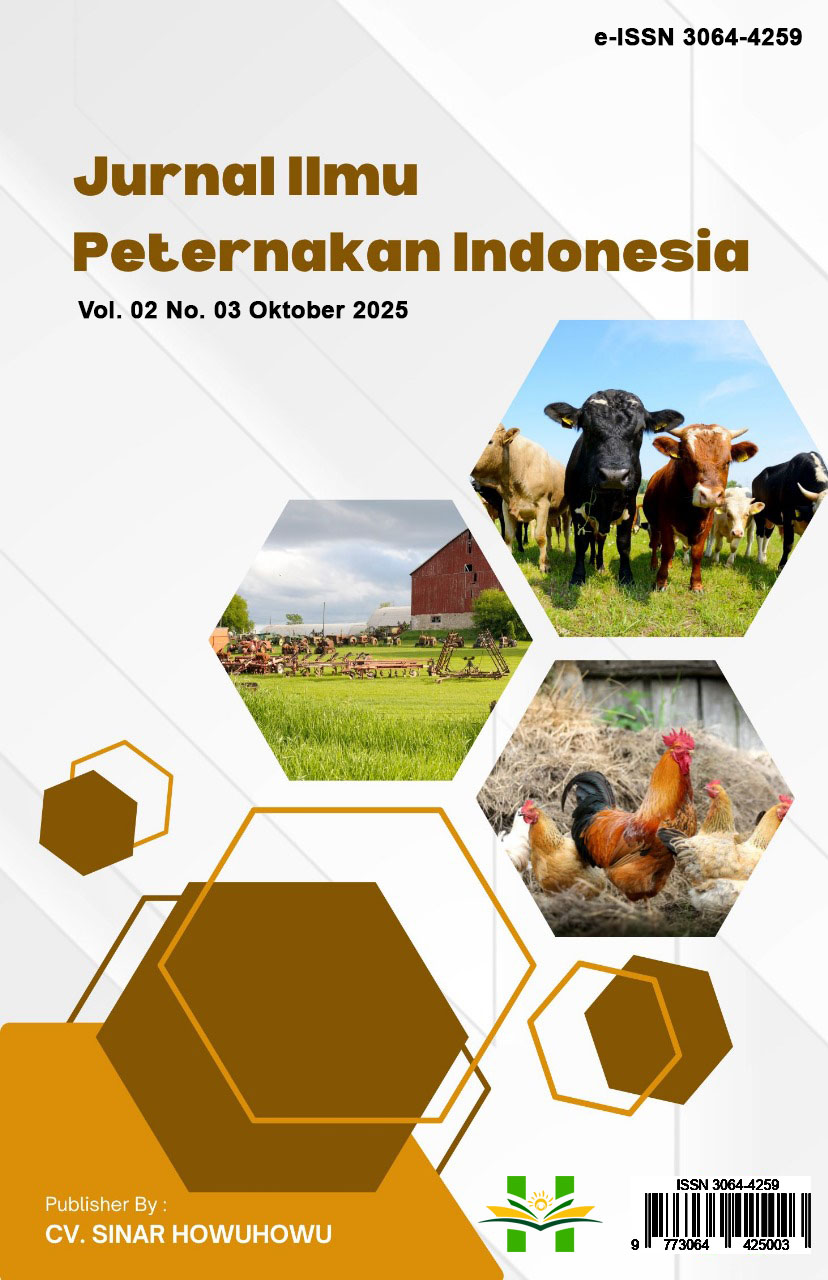Manajemen Reproduksi Sapi Potong Untuk Peningkatan Produktivitas Peternakan Rakyat
DOI:
https://doi.org/10.70134/jipena.v2i3.827Keywords:
reproductive management, beef cattle, artificial insemination, productivity, smallholder farmingAbstract
This study aims to analyze the reproductive management of beef cattle in smallholder farming systems and to identify the factors that influence their productivity. The research applied both descriptive-qualitative and quantitative methods, with data collected through interviews, field observations, and reproductive record analysis. The findings indicate that artificial insemination (AI) is the primary method applied by farmers, with an adoption rate of 85%. However, reproductive indicators such as service per conception (S/C), conception rate (CR), and calving interval (CI) remain below the ideal standards. The average S/C recorded was 1.9, the CR reached only 62%, and the CI ranged between 16–18 months. Nutritional deficiencies and reproductive health issues were identified as the main constraints, alongside limited farmer knowledge in estrus detection. Advanced reproductive technologies such as estrus synchronization and embryo transfer are still rarely implemented due to cost limitations, insufficient facilities, and lack of technical support. These findings highlight that improving beef cattle productivity through reproductive management requires an integrated approach, including improved feeding, reproductive health management, farmer training, and the adoption of appropriate reproductive technologies. With the right strategy, smallholder farming systems can significantly contribute to achieving national beef self-sufficiency.
Downloads
References
Arifiantini, R. I., & Sumantri, C. (2019). Teknologi reproduksi untuk peningkatan produktivitas sapi potong di Indonesia. Jurnal Veteriner, 20(1), 45–54. https://doi.org/10.19087/jveteriner.2019.20.1.45
Astuti, N. (2018). Manajemen reproduksi sapi potong pada peternakan rakyat. Jurnal Ilmu Ternak, 19(2), 110–118. https://doi.org/10.22146/jit.2018.19.2.110
Bastin, C., Gengler, N., & Soyeurt, H. (2011). Genetic improvement of reproduction traits in beef cattle. Animal, 5(4), 563–571. https://doi.org/10.1017/S1751731110002229
Boro, P., Dutta, D. J., & Barman, N. N. (2018). Estrus synchronization and artificial insemination in cattle. International Journal of Livestock Research, 8(5), 1–11. https://doi.org/10.5455/ijlr.20180505031435
Diskin, M. G., & Kenny, D. A. (2016). Managing the reproductive performance of beef cows. Theriogenology, 86(1), 379–387. https://doi.org/10.1016/j.theriogenology.2016.04.053
Figueiredo, R. A., & Baruselli, P. S. (2019). Reproductive technologies in cattle: Advances and perspectives. Animal Reproduction, 16(3), 465–472. https://doi.org/10.21451/1984-3143-AR2019-0077
Gaspersz, V. (2017). Strategi pengembangan sapi potong berbasis peternakan rakyat. Jurnal Agribisnis Indonesia, 5(2), 89–97. https://doi.org/10.29244/jai.5.2.89-97
Gunawan, A., Said, S., & Setiadi, B. (2020). Produktivitas dan perbaikan mutu genetik sapi potong di Indonesia. Jurnal Peternakan Indonesia, 22(3), 215–225. https://doi.org/10.25077/jpi.22.3.215-225
Handiwirawan, E., & Subandriyo. (2018). Peran nutrisi dalam mendukung reproduksi sapi potong. WARTAZOA, 28(1), 1–10. https://doi.org/10.14334/wartazoa.v28i1.1481
Hasler, J. F. (2014). Forty years of embryo transfer in cattle: A review focusing on the journal Theriogenology, the growth of the industry in North America, and personal reminisces. Theriogenology, 81(1), 152–169. https://doi.org/10.1016/j.theriogenology.2013.09.010
Lucy, M. C. (2019). Reproductive loss in high-producing dairy cattle: Where will it end? Journal of Dairy Science, 102(4), 3702–3713. https://doi.org/10.3168/jds.2018-15617
Lusiana, D., & Prasetyo, H. (2021). Efisiensi inseminasi buatan pada sapi potong rakyat di Jawa Tengah. Jurnal Ilmu Ternak, 22(1), 54–62. https://doi.org/10.22146/jit.2021.22.1.54
Mapiye, C., Chikwanha, O. C., & Dzama, K. (2019). Strategies for sustainable beef production in developing countries. Sustainability, 11(7), 1934. https://doi.org/10.3390/su11071934
Martinez, M. F., & Kastelic, J. P. (2016). Advances in reproductive technologies in beef cattle. Animal Frontiers, 6(4), 47–54. https://doi.org/10.2527/af.2016-0050
Morris, C. A., & Hickey, S. M. (2020). Genetic and environmental factors affecting calving interval in beef cows. Animal Science Journal, 91(1), e13373. https://doi.org/10.1111/asj.13373
Perry, G. A., & Cushman, R. A. (2016). Factors affecting fertility in beef and dairy cattle. Animal Reproduction, 13(3), 421–426. https://doi.org/10.21451/1984-3143-AR881
Rahman, A., & Yendraliza. (2021). Penerapan sinkronisasi estrus pada sapi potong rakyat. Jurnal Peternakan Nusantara, 7(2), 101–108. https://doi.org/10.31258/jpn.7.2.101-108
Roche, J. F., Mackey, D., & Diskin, M. D. (2000). Reproductive management of postpartum cows. Animal Reproduction Science, 60–61, 703–712. https://doi.org/10.1016/S0378-4320(00)00107-X
Saptana, & Ashari. (2017). Analisis daya saing daging sapi nasional dalam perdagangan global. Analisis Kebijakan Pertanian, 15(2), 109–124. https://doi.org/10.21082/akp.v15n2.2017.109-124
Sartika, T., & Yulianti, S. (2018). Faktor-faktor yang memengaruhi keberhasilan IB pada sapi potong. Jurnal Ilmu dan Teknologi Peternakan, 6(1), 22–29. https://doi.org/10.24843/jitp.6.1.22
Senger, P. L. (2012). Pathways to pregnancy and parturition. Current Conceptions.
Setiawan, B., Priyanto, R., & Kusuma, P. (2019). Efisiensi transfer embrio pada sapi potong di Indonesia. Buletin Peternakan, 43(4), 253–261. https://doi.org/10.21059/buletinpeternak.43.4.253
Shamsuddin, M., & Bhuiyan, M. M. U. (2020). Improving artificial insemination services in cattle in developing countries. Animal Reproduction, 17(3), e20190088. https://doi.org/10.21451/1984-3143-AR2019-0088
Silva, J. C. B., & Santos, R. M. (2019). Nutritional strategies to enhance reproductive efficiency in beef cattle. Animal Feed Science and Technology, 252, 47–54. https://doi.org/10.1016/j.anifeedsci.2019.03.014
Soeharsono, S., & Santoso, I. (2018). Hubungan tingkat pendidikan peternak dengan keberhasilan program inseminasi buatan. Jurnal Sosial Ekonomi Peternakan, 11(1), 12–21. https://doi.org/10.24198/jsep.11.1.12
Sotelo, M. J., & Randel, R. D. (2016). Estrus detection and reproductive efficiency in cattle. Journal of Animal Science, 94(6), 2325–2335. https://doi.org/10.2527/jas.2016-0322
Sudrajat, D., & Fitriani, N. (2020). Penyakit reproduksi pada sapi potong di peternakan rakyat. Jurnal Kedokteran Hewan, 14(3), 151–158. https://doi.org/10.21157/j.ked.hewan.14.3.151-158
Suharyati, S., & Yulianto, A. (2019). Evaluasi kinerja reproduksi sapi potong di peternakan rakyat. Jurnal Peternakan Tropika, 7(2), 133–140. https://doi.org/10.21776/ub.jpt.2019.007.02.8
Susilawati, T. (2020). Peranan inseminasi buatan dalam peningkatan mutu genetik sapi potong. Jurnal Ternak Tropika, 21(2), 145–153. https://doi.org/10.21776/ub.jtt.2020.021.02.5
Sutiyono, S., Wulandari, N., & Putra, B. (2020). Faktor yang memengaruhi keberhasilan reproduksi sapi potong. Jurnal Ilmu Ternak Indonesia, 22(3), 190–198. https://doi.org/10.22146/jiti.2020.22.3.190
Toelihere, M. R. (2019). Inseminasi buatan pada ternak. Bandung: Angkasa.
Walsh, S. W., Williams, E. J., & Evans, A. C. O. (2011). A review of the causes of poor fertility in high milk-producing dairy cows. Animal Reproduction Science, 123(3-4), 127–138. https://doi.org/10.1016/j.anireprosci.2010.12.001
Wiltbank, M. C., Baez, G. M., Garcia-Guerra, A., Toledo, M. Z., Monteiro, P. L. J., Melo, L. F., … Sartori, R. (2016). Pivotal periods for pregnancy loss during the first trimester of gestation in lactating dairy cows. Theriogenology, 86(1), 239–253. https://doi.org/10.1016/j.theriogenology.2016.04.037
Yendraliza, Y., Rahman, A., & Suharyanto. (2021). Aplikasi sinkronisasi estrus dalam meningkatkan efisiensi reproduksi sapi potong. Jurnal Ilmiah Peternakan Terpadu, 9(2), 222–230. https://doi.org/10.22302/jipt.9.2.222
Downloads
Published
Issue
Section
License
Copyright (c) 2025 Vivi (Author)

This work is licensed under a Creative Commons Attribution-ShareAlike 4.0 International License.













